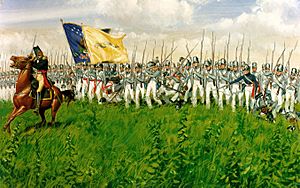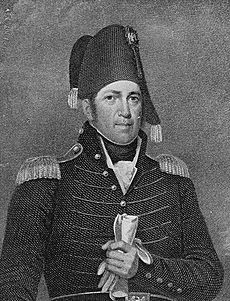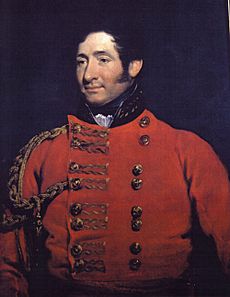Battle of Chippawa facts for kids
Quick facts for kids Battle of Chippawa |
|||||||
|---|---|---|---|---|---|---|---|
| Part of the War of 1812 | |||||||
 Brig Gen Winfield Scott leading his infantry brigade forward during the battle |
|||||||
|
|||||||
| Belligerents | |||||||
| Commanders and leaders | |||||||
| Phineas Riall | Jacob Brown Winfield Scott Peter Porter |
||||||
| Strength | |||||||
| 2,000 | 3,564, of which 2,109 were engaged | ||||||
| Casualties and losses | |||||||
| 108 dead 319 wounded 75 wounded prisoners 15 captured 18 missing |
60 killed |
||||||
| Official name: Battle of Chippawa National Historic Site of Canada | |||||||
| Designated: | 1921 | ||||||
The Battle of Chippawa was an important victory for the United States Army during the War of 1812. It happened on July 5, 1814, when American forces invaded Upper Canada, a British colony, near the Niagara River. This battle, along with the later Battle of Lundy's Lane, showed that well-trained American soldiers could fight just as well as experienced British soldiers. Today, the battlefield is a protected National Historic Site in Canada.
Contents
Why the Battle of Chippawa Happened
In early 1814, it was clear that Napoleon had been defeated in Europe. This meant that many skilled British soldiers, who had been fighting in the Peninsular War, would soon be sent to Canada. The American Secretary of War, John Armstrong Jr., wanted the United States to win a big victory in Canada before these British reinforcements arrived.
Major General Jacob Brown was put in charge of the "Left Division" of the American army. Armstrong wanted him to attack Kingston, which was the main British base on Lake Ontario. A smaller attack by militia across the Niagara River was planned to distract the British. However, Brown couldn't get help from Commodore Isaac Chauncey, who led the American navy on Lake Ontario. Chauncey was waiting for new warships to be built. Because of this, Brown decided to make the attack across the Niagara River his main goal.

Training for Battle: Scott's Camp
Armstrong also ordered two special "Camps of Instruction" to be set up. These camps were meant to make the American army's regular units better. One camp was in Buffalo, New York, led by Brigadier General Winfield Scott.
At Buffalo, Scott started a tough training program. His soldiers drilled for ten hours every day, using a French army training manual from 1791. Before this, different American regiments used different manuals, making it hard for large groups of soldiers to work together. Scott also removed officers who weren't good at their jobs and made sure the camp was clean. This helped reduce sickness among the troops.
There was one small problem: Scott couldn't get enough blue uniforms for his men. So, many soldiers received short jackets made of grey cloth instead. Scott even gave his own brigade's blue coats to another unit, saying their black coats were a "disgrace."
The Niagara Campaign Begins
By early July, General Brown's army was gathered at the Niagara River. Since the navy wouldn't help, a direct attack on Fort George was not possible. Brown decided to capture Fort Erie, which was across the river from Buffalo. He planned to push even further after that.
On July 3, Brown's army easily captured Fort Erie. It was defended by only a few British soldiers. After more American volunteers and Iroquois warriors joined them, General Scott began moving north along the road next to the Niagara River. A small British force tried to stop them but was quickly pushed back.
Later that day, Scott's troops met British defenses near Chippawa. After a short fight, Scott pulled back a few miles to Street's Creek. He planned to have a Fourth of July parade there the next day.
The British forces were led by Major General Phineas Riall. Riall thought that Fort Erie was still fighting, and that the Americans facing him were mostly militia, not strong regular soldiers. He decided to cross the Chippawa River and attack, hoping to push the Americans back.
The Battle of Chippawa
On the morning of July 5, British light infantry, militia, and Native American allies crossed the Chippawa River. They began shooting at Scott's outposts from the nearby woods. General Brown ordered an American brigade and Native American allies to clear the woods. They did, but then they ran into Riall's main British army and had to retreat quickly.
Scott's troops were already moving forward from Street's Creek. Their artillery, led by Captain Nathaniel Towson, set up on the road and began firing. The British guns tried to fire back, but Towson's cannons destroyed an ammunition wagon and put most of the British guns out of action.
Scott's soldiers formed a long line. At first, General Riall thought the grey-clad American soldiers were just militia, whom British soldiers didn't respect much. He expected them to run away after the first few shots. But the American line held steady under fire. Riall then realized his mistake and supposedly said, "Those are regulars, by God!"
The British soldiers advanced in a long line, which was difficult over the uneven ground and long grass. This made them move slowly and stay under American artillery fire for longer. The American gunners then switched to firing canister, which was like a giant shotgun blast, causing many casualties among the British. When the two armies were less than 100 yards apart, Scott moved his troops to form a "U" shape. This allowed his soldiers on the sides to fire at the British from multiple directions.
Both sides fired many shots. After about 25 minutes of intense fighting, General Riall, who had been hit by a bullet, ordered his troops to retreat. The British soldiers fell back, covered by their remaining cannons. Scott stopped his brigade, though some of the American Native American allies chased the British almost back to the Chippawa River.
Battle Losses
The American army reported that 60 of their soldiers were killed, 249 were wounded, and 19 were missing.
The British suffered heavy losses. One British regiment, the 100th Regiment, had many soldiers killed or wounded. In total, British losses were about 108 killed, 319 wounded, 75 wounded and captured, 15 captured without wounds, and 18 missing.
What Happened After the Battle
Two days after the battle, General Brown moved his army across the Chippawa River, forcing the British to retreat to Fort George. However, Brown couldn't attack Fort George because Commodore Chauncey still hadn't brought naval support or siege cannons. Meanwhile, the British received more soldiers, making them too strong for Brown to attack directly. This led to another major battle, the Battle of Lundy's Lane, a few weeks later.
Legacy of Chippawa
The Battle of Chippawa, along with the Battle of Lundy's Lane, proved that American regular army units could fight well against experienced British soldiers if they were properly trained and led. Many believe that General Riall was too confident and made mistakes in his tactics, which led to the high number of British casualties.
The 6th Infantry Regiment of the United States Army uses the motto "Regulars, by God!" because of this battle. Many active U.S. Army infantry battalions today carry on the history of the regiments that fought at Chippawa.
The gray parade uniforms worn by the cadets at the United States Military Academy at West Point are sometimes said to be in honor of Scott's grey-clad troops at Chippawa. However, the real reason they chose grey in 1815 was that it lasted longer and was cheaper than blue uniforms.
The battle site is now the Chippawa Battlefield Park, managed by the Niagara Parks Commission. It has a monument and signs explaining the battle. The site was named a National Historic Site of Canada in 1921.
Chippewa Square in Savannah, Georgia, is named after the battle, even though it spells "Chippawa" incorrectly.
Images for kids
-
Map of the Niagara Frontier in 1814 showing the locations of the Battle of Chippawa and Lundy's Lane. After Lundy's Lane, American forces retreated to Fort Erie.
See also
 In Spanish: Batalla de Chippawa para niños
In Spanish: Batalla de Chippawa para niños





